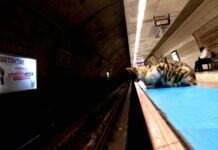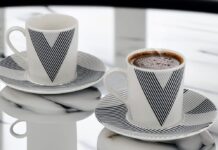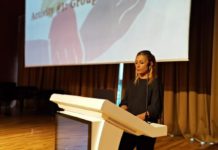Every year the Designer-in-Residence program at ATÖLYE sparks newfound life in the hub’s impressive Prototyping Lab – an opportunity to conceptualize, experiment, and share discoveries with both the in-house community, as well as the public at large in the form of an open exhibition. This past season saw resident Selen Sariel regularly putting in hours of work and building on her academic and practical experiences as an industrial designer – a field she clearly possesses great passion for. Her trajectory towards industrial design is one that seems fated, evolving off a lifetime of interest in utilizing hands on methodology of creating new things, ranging from the artistic and abstract to more practical creations, and always with a respect for the process itself. Her enthusiasm for the field translates well into her role as a lecturer at university, sharing her knowledge with aspiring industrial designers and tackling more nuanced aspects of the surrounding academia. Her time at ATÖLYE was one that emphasized collaboration and input, and brought together members of the community, often turning the lab into a center of movement and activity as her various projects utilized the human body to correspond with modern technologies and applications. Approaching new programs and concepts with open curiosity, Selen embraced the unknown in many aspects of her tenure, and was a true embodiment for the vision of the program itself.
We took some time to speak with Selen on the scope and intricacies of industrial design, the unique pursuits and experimentation of her time in ATÖLYE’s Designer-in-Residence program, the many possibilities and complexities of the sector, and what comes next for this ambitious designer.
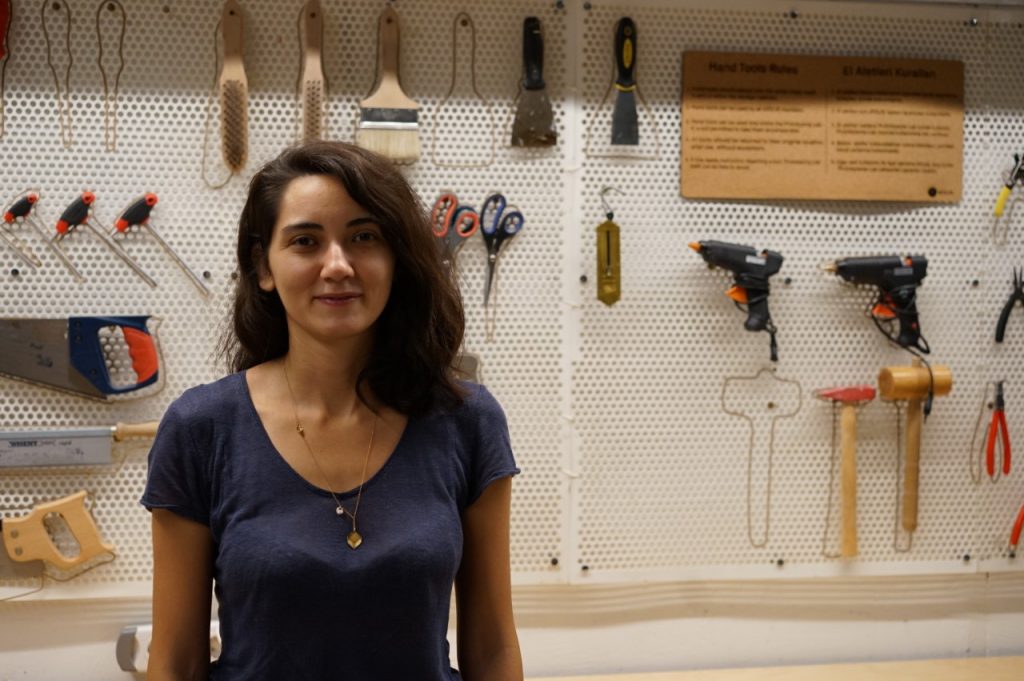
Could you tell us a little bit about yourself?
Sure. I am an industrial designer. I have been working on different projects – including visual and structural design, design research and production. Last year I started as an assistant lecturer in “Fundamentals of Design” at Istanbul Medipol University, and this year I continue as a visiting lecturer for the “Human Factors in Design” course at Istanbul Bilgi University. Besides work, I enjoy outdoor sports, especially rock climbing. I go climbing every so often and enjoy it as sports and leisure.
What started your interest in industrial design?
I have always had an interest in building and making things. As a child, I remember doing these flash projects as a child where I’d start in the day and finish by the evening. I was interested in painting – not only artistic and figurative works – but also painting furniture or walls. I love working with colors. Besides that, I was enjoying doing simple scientific experiments with my sister. I had originally wanted to be an architect as a child, then however, the scale of industrial design interested me a lot. As the years passed, I got even more excited as I figured out that industrial design can be a practice connecting creative fields like art, science, architecture, fashion and more.
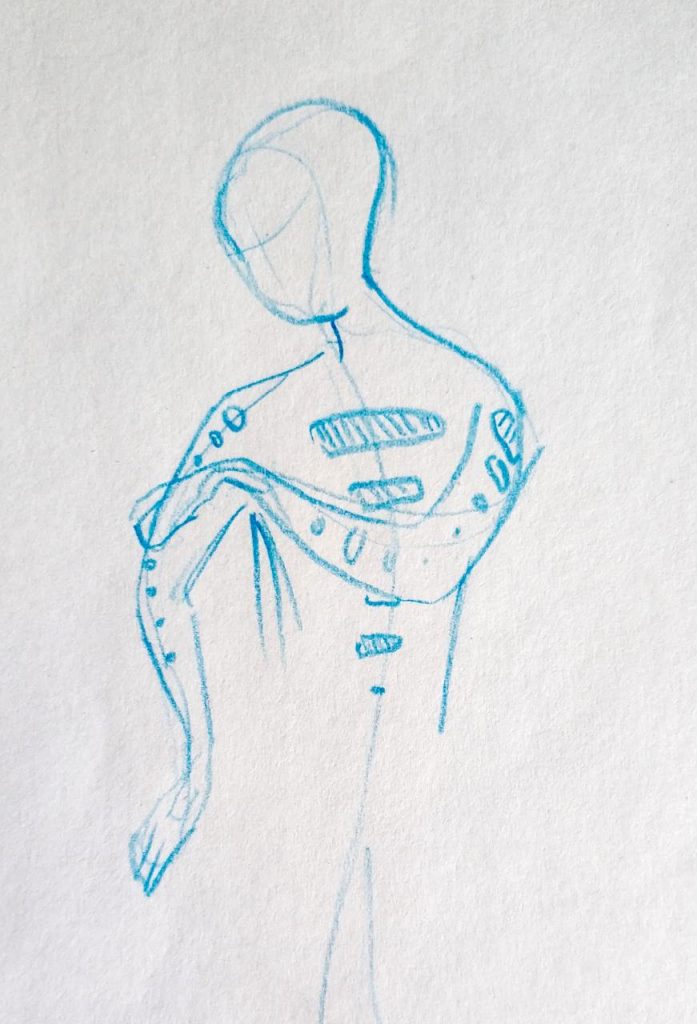
Could you elaborate a bit on what ‘industrial design’ is?
Sure, I can try to explain what it means to me at least. Industrial design products are scaled to the human body, which you can touch and interact with directly. But of course someone else could frame it in a different way. For example, industrial design is something designed through technological possibilities – whatever you have to work with, that is available to you at that time and place. It includes designing with the elements, the current industry, and what the environment has to offer. Designing an architectural detail or an event – industrial design could find various areas to integrate.
Are there specializations within industrial design or is it recognized more generally as its own specialization?
That’s a good question actually. It is recognized as a good thing to be specialized in an area, for example, with materials or in a production method. It really depends on one’s interest, their roadmap, and the available industrial resources surrounding them. I like to explore as much as possible before going into the details of certain materials and production. My roadmap is to have a deeper understanding of our nature as humans, and understand our environment. The technological application of an idea comes after. Technology has evolved rapidly as I was studying design, as did the products that we use. Industrial design means designing with the possibilities of technologies that are available, and right now there are new technologies to be rediscovered through design. That’s why I’d seek for exploring these possibilities, and specializing is fundamental for industrial designers to collaborate with other disciplines while implementing an idea.
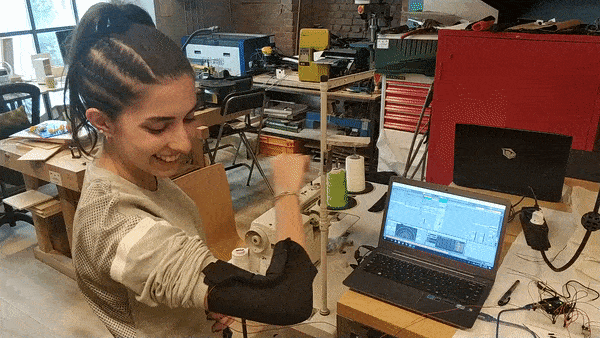
What did you have in mind when you applied to the designer in residency program at ATÖLYE?
For me, another definition of design is to connect the things we know, in ways we don’t know yet. I heard about this phrase years ago as a design student, wrote it down on a piece of paper, and placed it where I can see it from my studio desk. Back then I didn’t think about noting who said this. Then recently I read a similar concept in one of Ursula Le Guin’s books.
When I thought about applying to the residency program at ATÖLYE, I knew it would be a great place to learn and collaborate, and connect different things in new ways.
Even though I graduated in 2015, I always consider myself a student and hope to learn from opportunities. My graduate thesis focused on wearables and technology. I had questions for the products we use today and how they fit into our daily lives. I don’t want to complicate my explanation further, but during my thesis I had hoped to design a product that would solve our distraction problem with smartphones. It was quite ambitious. [Laughter.]
Back then my concern was the general usage of the technology that make us immobile and distracted. For the residency, I didn’t have any particular projects in mind, but I really wanted to explore areas to provide more active interaction alternatives to the users of contemporary technologies.
During the residency I used Arduino, which is a microprocessor that can be programmed to respond to data read from connected sensors. You can do so many different things with it. Because of all the possibilities, I wanted to have a blank state to start with and find inspiration in the designer-in-residency program.

In the two month period of the designer-in-residency program, what was your workflow like?
A very inspirational designer for me, Ayşe Birsel, had a quote, “define the life to design the product”. In the beginning, I had a character dancing in my mind. I needed to design a costume for this character, so we could hear them dance! So as I worked with the circuit of sensors, I also searched for flexible materials to integrate this circuit on a garment.
I didn’t have a daily typical workflow honestly. But I did kept a record of what I needed to make the final exhibition a reality. I kept my brief updated. I’d take notes on what I needed to present the concepts I work on – the materials needed, or if I would need help with code, or to calibrate the sensors, and so on. I would do this in the beginning and ending of a work session usually.
During my feedback sessions I emphasized not focusing on one problem to solve during the residency. I thought I had already limited time to choose one thing and try to solve that. Instead I tried to explore body movements and how to design an interaction integrating flex sensors. How can we safely wear these sharp edged materials? Is it possible to make DIY flex sensors with soft materials? I tried to explore possibilities.
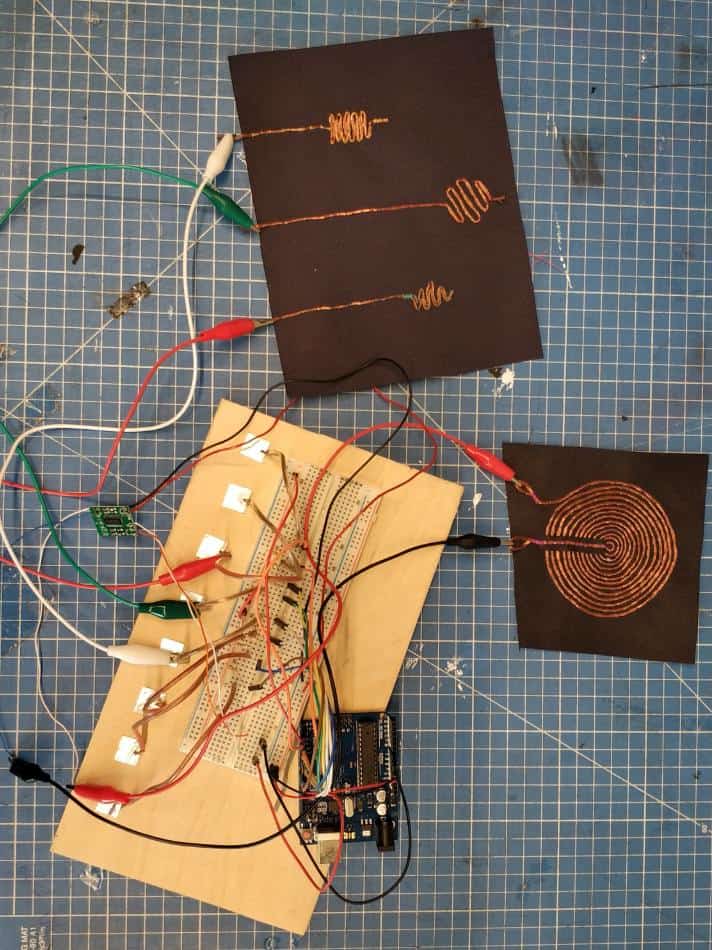
You mention the exhibition. What was that like?
I had three concepts in the exhibition.
So as a first idea, I put flex sensors at points on body joints. I called it the Flex Suit. During my time in residency we tried this suit with different sounds. So a tune is filtered as we move our body, and we hear different rhythms or sounds. It was interesting to see how a garment – clothing we put on – could spark curiosity about performing different body gestures.
Another project was a sound jacket. I used capacitive sensing technologies, like those found on touch screens of our smartphones. In the beginning I had copper wire embroidered on fabrics and I created several different Interfaces to interact with. Then I designed a layout on a chef’s jacket, using conductive fabric. The sounds are very simple, I didn’t go into designing sounds — yet.
And the third project?
The third project was a collaborative project. It was the only one started with a focus on a problem to solve. The brief came from a community member: designing a device to help him keep track of his time spent on various projects, to help with his freelance workload.
Then we started sharing ideas, and came up with designing an experience wearing a work apron. Beforehand, I had experimented a lot with embroidered speakers on fabric. I saw experiments made by Kobakant, and made my own speakers with the materials I had. The speakers work with magnets, and without the magnets you can’t hear the sound. The apron has three speakers embroidered on it and one magnet – I call it the “The Attention Magnet – which depended on the project he was working on. Depending on the playlists he was listening to and which speaker the magnet was connected to, it would keep track of the time.
For this project I invited a friend over to ATÖLYE – who recently started experimenting with data visualization. I asked him if it he could help with reading the data from The Attention Magnet, so that we could visually track the time.

What are your impressions from this experience and moving forward more generally?
One of the main challenges was facing the unlimited possibilities of using Arduino. Additionally Ableton Software – which I recently learned about from an ATÖLYE community member – has its own vast universe. So I left my comfort zone for explorations with Arduino and Ableton. During my time in residency, focusing on music and movement really helped me explore in a way I wouldn’t have otherwise. It was also a great opportunity to learn more about the technical side of music. Community members who had experience in the music industry helped me a lot with their feedback and suggestions.
During this phase, I explored a variety of digital and analog sensors, and their working principles. Online tutorials, DIY documentations and example works such as Hannah Perner-Wilson’s Sewn Speakers and Neoprene Bend Sensors, Mika Satomi’s Puppeteer Project, Imogen Heap’s MiMu Gloves, and Erkki Kurenniemi’s DIMI Ballet were helpful to construct the theory and practice of my projects.
Exploring was inspiring and fun, but now it’s time to focus on improving. Like I mentioned in the beginning about design, there’s a time for exploring and also for focusing on one thing. Concluding a two month exploration period, I found something that is in one way exciting and new, but also something I’ve always been interested in.
As we’re a publication read by foreigners who might be new to Istanbul, do you have any suggestions for them?
I have a walking route from Yenikapı to Eminönü, then crossing the bridge towards one of my favorite parts of the city, Karaköy. I like the small manufacturing workshops on the narrow streets, and shops selling industrial parts. People work over there seem to know each other, and ready to help you with what you look for. That’s where I always went as a student all the time to buy supplies or have some parts made for projects. I also did spend some time there for my residency projects. Karaköy is a great place to explore.
ATÖLYE Spotlight is our series on the inspiring community members of Istanbul’s most creative space.
All images courtesy of the interviewee.




